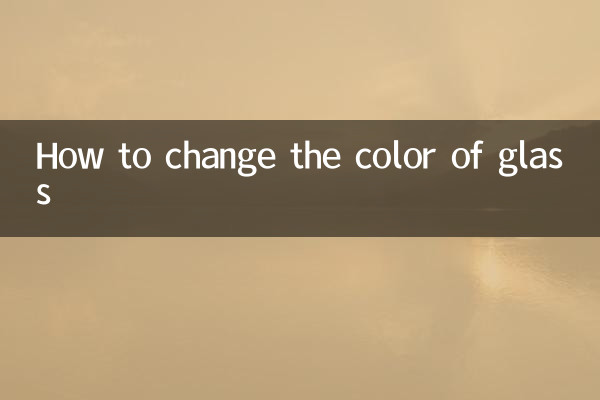Title: How to change the color of glass? Revealing the magical applications of technology and life
In recent years, glass discoloration technology has become one of the hot topics due to its wide range of application scenarios and technological features. Whether in the field of architecture, automobiles or smart homes, color-changing glass has shown great potential. This article will combine the hot content on the Internet in the past 10 days to provide you with a detailed analysis of the principles, methods and applications of glass discoloration.
1. The principle of glass discoloration

Glass discoloration is mainly achieved in the following three ways:
| Color change method | principle | Common applications |
|---|---|---|
| electrochromic | Adjusting the light transmittance by changing the redox state of the material in the glass by applying a voltage | Smart windows, car sunroofs |
| photochromic | Utilize photosensitive materials to undergo molecular structure changes under ultraviolet irradiation | sunglasses, architectural glass |
| Thermochromic | Temperature changes cause changes in the optical properties of materials | Temperature-controlled glass, energy-saving buildings |
2. Recently popular color-changing glass technology
According to the technology hot spots in the past 10 days, the following color-changing glass technologies have attracted much attention:
| Technical name | Features | R&D institutions |
|---|---|---|
| Nanocrystal electrochromic glass | The color changing speed is increased to within 1 second and can be recycled more than 100,000 times. | MIT research team |
| Self-healing photochromic film | It can be repaired automatically after being scratched, and its lifespan is extended by 5 times. | University of Tokyo |
| Graphene color changing glass | Energy consumption is reduced by 60%, and the transparency adjustment range is wider | Cambridge University |
3. DIY glass discoloration method
For ordinary consumers, the glass discoloration effect can also be achieved through the following simple methods:
| method | Material | Operation steps |
|---|---|---|
| color changing film | PDLC or EC film | 1. Clean the glass surface 2. Cut the film to size 3. Fit and remove air bubbles |
| Spray color changing liquid | Photochromic spray | 1. Mask areas that do not need to be sprayed 2. Spray 2-3 layers evenly 3. Natural drying for 24 hours |
| discoloration of interlayer | Color changing PVB interlayer film | 1. Glass cleaning treatment 2. Place the color-changing film 3. High temperature and high pressure lamination |
4. Market application hot spots of color-changing glass
According to the latest industry data, color-changing glass is growing rapidly in the following areas:
| Application areas | Growth rate in 2023 | Main brands |
|---|---|---|
| smart building | 28.5% | View,SageGlass |
| Automotive industry | 35.2% | Tesla, Mercedes-Benz |
| consumer electronics | 42.7% | Xiaomi, Samsung |
5. Future development trends
Based on recent technology media reports, glass discoloration technology will show the following development trends:
1.Increased intelligence: Combined with the Internet of Things to achieve automatic adjustment and scene linkage
2.Costs continue to fall: Large-scale production makes prices more affordable, and prices are expected to drop by 40% in 2025.
3.Enhanced environmental performance: Breakthrough progress in the research and development of bio-based color-changing materials
4.Multifunctional integration: It has multiple functions such as power generation, sound insulation, and self-cleaning.
Conclusion: Glass discoloration technology is moving from high-end applications to daily life. With technological advancement and cost reduction, we will see this "magic glass" in more scenes in the future. Whether it is energy saving, environmental protection or life convenience, color-changing glass will play an important role.

check the details

check the details